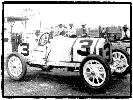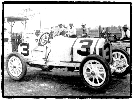3/6/1878 - 4/10/1946
Record updated 10-Mar-23
Bern Eli 'Barney' Oldfield was one of the greatest drivers and showmen of the early days of racing in the USA.

Born in Wauseon, Ohio, Barney was constantly in trouble for his uncouth ways and loud mouth.
Born Berna Eli Oldfield, his first love was cycling and by 1894 he had won silver medals and a gold watch from racing. In 1896, he was being paid handsomely by the Stearns bicycle factory to race. The League of American Wheelmen were appalled that "paid amateurs" were involved with bicycle racing. Threatened with being blacklisted, Oldfield outfoxed the league by forming his own team, Amateur Athletic Foundation of Los Angeles.
At one point, Oldfield switched to boxing, a sport that promised a bigger paycheck. Billed as the "Toledo Terror," his career as a pugilist was cut short by an attack of typhoid fever and he returned to bike racing.
Six years later, a man lent him a gasoline-powered bicycle to race in salt Lake City, where Oldfield had moved, and it was this association led to a meeting with Henry Ford, who had prepared two race cars in 1902.
Henry Ford wanted to stop racing after one or two starts in the now famous number 999 Ford car. Henry wanted to have Oldfield test his cars, since Oldfield had never driven a car before. Both cars didn't start. Ford sold both cars to Oldfield for $800.

Oldfield agreed to drive one of the Fords against the then current champion Alexander Winton. Oldfield learned how to operate the car the morning of the event, and won by a half mile in the five mile race. He slid through the corners like a motorcycle racer did instead of braking. It was a great victory for Ford and led both Barney Oldfield and Ford to become household names.
He drove in a match race on Memorial Day weekend in New York in 1903, and was the first driver to drive a mile track in one minute flat or 60 mph (miles per hour). Two months later he drove a mile in 55.8 seconds, and Winton hired Oldfield. Oldfield was under contract to J Alexander Sloan and Will Pickens, who proclaimed him as 'Master Driver of the World'. He travelled all over the United States in a series of timed runs and match races, where he earned a reputation as a showman. One year he competed at twenty tracks in 18 weeks, and had four exhibition run and won sixteen straight match races.
Oldfield was the first American to become a celebrity solely for his ability to drive a car with great skill, speed, and daring. Racing became very lucrative for Oldfield, and by his career's end he could command at least a thousand dollars just to show up for a race. All this was at a time when Henry Ford's 5$ a day wage was considered incredibly high. Soon this wealthy racing phenomenon was living a truly extravagant lifestyle, hanging out with the most elite crowd and showing up for races in his own private railway car. At the time when Oldfield was racing, only a small segment of the population could afford automobiles, and being a race car driver placed him among the highest class in society.

He bought a Benz, and raised his speed in 1910 to 70.159 mph in his "Blitzen Benz". Later that year he drove to 131.25 mph. He used the car to break the existing mile, two mile, and kilometer records at the Daytona Beach Road Course at Ormond, Florida. He was able to charge $4000 U.S. dollars for each appearance after that. He was suspended by the AAA for his "outlaw" racing activities and was unable to race at sanctioned events for much of the prime of his career. Speed records, match races and exhibitions made up most of Oldfield's career.

Barney Oldfield relished the fame that racing brought him, and soon he was moving from the race track onto the big screen and the Broadway stage. Oldfield played in a Broadway musical entitled The Vanderbilt Cup with co-star Elsie Janis and toured with the show for ten weeks. Oldfield also starred in several movies, including a 1913 silent film called Barney Oldfield's Race for a Life, in which he races a train in order to save heroine Mabel Normand, who has been tied to the tracks by the villain played by Rod Sterling. Of course, Oldfield saves the day due to his ability to drive his automobile with such great speed. Historian Mark Howell notes that, "Perhaps there is something symbolic in the fact that Barney Oldfield outraced a locomotive in this film, as though the automobile, by 1913, had exceeded the railroad in terms of American importance" (Howell 229). Oldfield himself and his huge celebrity status is indicative of a culture fascinated with automobiles and with pushing the limits of their potential. However, what made Oldfield special is that he could win lots of races even when he didn't have the fastest car due to his great skill behind the wheel.

The Golden Submarine
Oldfield made a gold car that completely enclosed the driver (called the "Golden Submarine"). In June 1917 he used the Golden Submarine to beat fellow racing legend Ralph DePalma in a series of 10 to 25 mile match races at Milwaukee. He retired from racing in 1918, but he continued to tour and make movies.
Oldfield was a showman both on and off the track. On the track, in a best of three heat race, Oldfield was known to win the first heat by a nose, then lose the second on purpose, only to add drama to the final heat in which he would clinch the victory. Although somewhat artificial, Oldfield sought to give his fans some excitement when they came to watch him race.
Drivers today are still just as eager to please their fans, though today's competition is much tougher than in Oldfield's day, and toying with your opponents is no longer an option even for the best racers. Oldfield's career spans the time during which auto-racing went from being a fascinating novelty and wonder of technology to becoming a respectable, organized sport. Oldfield also was the first to have the outlaw image as a driver, facing numerous suspensions from the AAA (American Automobile Association), which attempted to govern most early racing events.
Oldfield was a rowdy character known to get into plenty of barfights, and had an off-the-track reputation much like that of Babe Ruth off the ball field. Oldfield, sadly enough, also had a good part in keeping blacks out of auto-racing. Oldfield raced champion boxer Jack Johnson with the primary goal of proving the superiority of the white race, especially in auto racing, since the heavyweight boxing champ was African American. Racing has remained almost a totally white sport ever since. All in all, Oldfield left future stock car racers with the legacy of being daredevils, but also for those crazy enough to risk their lives racing cars, he left the hope of earning a great deal of money and fame.
Barney Oldfield also helped fellow racer Carl G. Fisher found the Fisher Automobile Company in Indianapolis, Indiana, which is believed to be the first automobile dealership in the United States.

He developed the Oldfield tire for Firestone, which help put Firestone on the map. Firestone used the slogan "'Firestone Tires are my only life insurance,' says Barney Oldfield, world's greatest driver."
Barney Oldfield officially retired from racing in 1918, but on occasion would still climb behind the wheel. In 1927, he averaged 76.4 mph in a 1,000-mile nonstop stock car event at Culver City in California. Oldfield was living in Beverly Hills when he died in 1946.
During the 1930s, Henry Ford visited Oldfield at his home in California. During their conversation, Ford told his former driver, "Barney, I made you and you made me." Oldfield shook his head and said, "No, Henry, old No. 999 made us both."
He was buried in the Holy Cross Cemetery in Culver City, California.
historicracing.com
POPULAR DRIVERS FROM USA
Tony Renna
Herman Beam
Red Byron
Pee Wee Jones
Curtis Turner
Al Herman
Donald Hoag
Hap Sharp
Grover Bergdoll
Johnnie Tolan

Barney Oldfield in the 5th placed Stutz-Wisconsin in the 1914 Indy 500.

Barney Oldfield in the Stuts-Wisconsin that finished 5th in the 1914 Indy 500